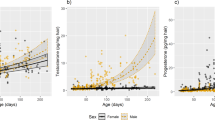Summary
Newborn rabbits are completely dependent on a pheromone on the mother's belly for the release of nipple-search behaviour and suckling. Using the stereotyped behavioural response of the pups as a bioassay it could be shown that:
-
1.
In non-breeding does pheromone emission is stimulated by experimental long day and suppressed by experimental short day conditions within 1 to 2 weeks of reversing the light regime.
-
2.
Under constant long day conditions pheromone emission, readiness to mate, conception rate and litter size remain high with no evidence of endogenous seasonal rhythmicity.
-
3.
Experimental changes in daylength of just 1 or 2 h in either direction are sufficient to induce marked alterations in the level of pheromone emission, number of successful matings and average litter size within 2 to 3 weeks.
Pheromone emission would thus seem to provide a sensitive test of photoperiodic responsiveness in nonbreeding female rabbits, and a convenient, non-invasive indicator of their reproductive state.
Similar content being viewed by others
Abbreviations
- L/D :
-
h light/h dark
References
Andersson M, Meurling P (1977) The maturation of the ovary in wild rabbits, Oryctolagus cuniculus, in southern Sweden. Acta Zool (Stockh) 58:95–101
Andersson M, Meurling P, Dahlbäck M (1979a) Biology of the wild rabbit, Oryctolagus cuniculus, in southern Sweden. I. Breeding season. Swed Wildl Res (Viltrevy) 11:101–127
Andersson M, Borg B, Meurling P (1979b) Biology of the wild rabbit, Oryctolagus cuniculus, in southern Sweden. II. Modifications in the onset of breeding, in relation to weather conditions. Swed Wildl Res (Viltrevy) 11:129–137
Borg B, Andersson M, Meurling P (1978) Biology of the wild rabbit, Oryctolagus cuniculus, in southern Sweden. III. Histology of the uterus in the non-breeding season. Acta Zool (Stockh) 59:253–260
Boyd IL (1985) Effect of photoperiod and melatonin on testis development and regression in wild European rabbits (Oryctolagus cuniculus). Biol Reprod 33:21–29
Boyd IL (1986a) Effect of daylength on the breeding season in male rabbits. Mammal Rev 16:125–130
Boyd IL (1986b) Photoperiodic regulation of seasonal testicular regression in the wild European rabbit (Oryctolagus cuniculus). J Reprod Fert 77:436–470
Boyd IL, Myhill DG (1987) Seasonal changes in condition, reproduction and fecundity in the wild European rabbit (Oryctolagus cuniculus). J Zool (Lond) 212:223–233
Brambell FWR (1944) The reproduction of the wild rabbit Oryctolagus cuniculus (L). Proc Zool Soc Lond 114:1–45
Carson WS, Amann RP (1972) The male rabbit. VI. Effects of ejaculation and season on testicular size and function. J Anim Sci 34:302–309
Dahlbäck M, Andersson M (1981) Biology of the wild rabbit, Oryctolagus cuniculus, in southern Sweden. VI. Leydig cell activity and seasonal development of the male accessory organs of reproduction. Acta Zool (Stockh) 62:113–120
Farrell G, Powers D, Otani T (1968) Inhibition of ovulation in the rabbit: Seasonal variation and the effect of indoles. Endocrinol 83:599–603
Friedman MH (1938) Criteria for the selection of oestrus in rabbits. The significance of occasional factors. Endocrinol 22:354–359
Gwinner E (1986) Circannual rhythms. Springer, Berlin Heidelberg New York
Hammond J, Marshall FMA (1925) Reproduction in the rabbit. Oliver and Boyd, Edinburgh
Hoffmann K (1981) Photoperiodism in vertebrates. In: Aschoff J (ed) Handbook of behavioral neurobiology. Vol 4: Biological rhythms. Plenum, New York, pp 449–473
Hudson R, Distel H (1983) Nipple location by newborn rabbits: Behavioural evidence for pheromonal guidance. Behaviour 85:260–275
Hudson R, Distel H (1984) Nipple-search pheromone in rabbits: Dependence on season and reproductive state. J Comp Physiol A 155:13–17
Hudson R, Distel H (1989) The temporal pattern of suckling in rabbit pups: a model of circadian synchrony between mother and young. In: Reppert SM (ed) Development of circadian rhythmicity and photoperiodism in mammals. Perinatology Press, Boston, pp 83–102
Hudson R, González-Mariscal G, Beyer C (1990) Chin marking behavior, sexual receptivity and pheromone emission in steroid treated, ovariectomized rabbits. Horm Behav 24:1–13
Kamwanja LA, Hauser ER (1983) The influence of photoperiod on the onset of puberty in the female rabbit. J Anim Sci 56:1370–1375
Keil W, Stralendorff F v, Hudson R (1990) A behavioral bioassay for analysis of rabbit nipple-search pheromone. Physiol Behav 47:525–529
Lloyd MG (1970) Variation and adaptation in reproductive performance. Symp Zool Soc Lond 26:165–188
Myers K, Poole WE (1962) A study of the biology of the wild rabbit, Oryctolagus cuniculus (L.), in confined populations. III. Reproduction. Aust J Zool 10:225–267
Mykytowycz R, Fullagar PJ (1973) Effect of social environment on reproduction in the rabbit, Oryctolagus cuniculus (L.). J Reprod Fert Suppl 19:503–522
Paufler SK, Van Vleck LD, Foote RH (1969) Estimation of testicular size in the live rabbit. Int J Fert 14:188–191
Pericin C, Grieve AP (1984) Seasonal variation in temperatures in rabbits. Lab Anim 18:230–236
Poole WE (1960) Breeding in the wild rabbit Oryctolagus cuniculus (L.) in relation to the environment. CSIRO Wildl Res 5:21–43
Sawyer CH (1959) Seasonal variation in the incidence of spontaneous ovulation in rabbits following estrogen treatment. Endocrinol 65:523–525
Shipp E, Keith K, Hughes RL, Myers K (1963) Reproduction in a free-living population of domestic rabbits, Oryctolagus cuniculus (L.), on a sub-antarctic island. Nature 200:858–860
Skira IJ (1978) Reproduction of the rabbit, Oryctolagus cuniculus (L.), on Macquarie Island, subantarctic. Aust Wildl Res 5:317–326
Stephens MN (1953) Seasonal observations on the wild rabbit Oryctolagus cuniculus (L.) in West Wales. Proc Zool Soc Lond 122:417–434
Walter MR, Martinet L, Moret B, Thibault C (1968) Regulation photopériodique de l'activité sexuelle chez le lapin mâle et femelle. Arch Anat Histol Embryol 51:773–780
Watson JS (1954) Breeding season of the wild rabbit in New Zealand. Nature 174:608–609
Wood DM (1980) The demography of a rabbit population in an arid region of New South Wales, Australia. J Anim Ecol 49:55–79
Author information
Authors and Affiliations
Rights and permissions
About this article
Cite this article
Hudson, R., Distel, H. Sensitivity of female rabbits to changes in photoperiod as measured by pheromone emission. J Comp Physiol A 167, 225–230 (1990). https://doi.org/10.1007/BF00188115
Accepted:
Issue Date:
DOI: https://doi.org/10.1007/BF00188115




